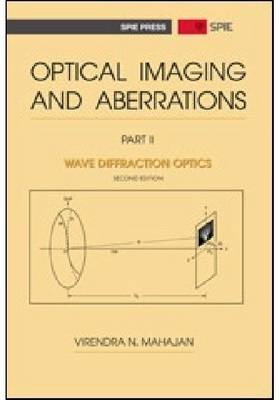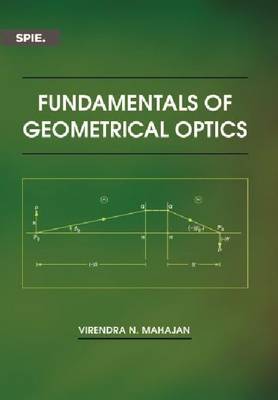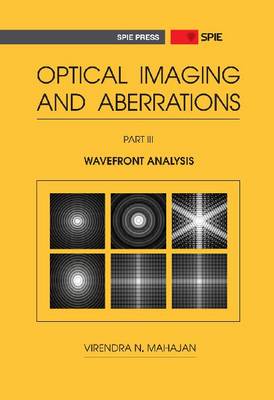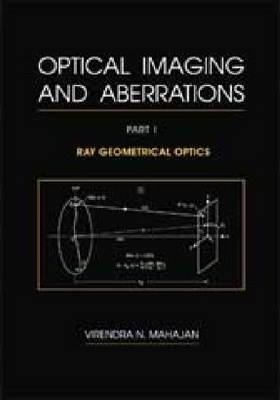Press Monographs
5 total works
Ten years have passed since the publication of the first edition of this classic text in April 2001. Considerable new material amounting to 100 pages has been added in this second edition. Each chapter now contains a Summary section at the end. The new material in Chapter 4 consists of a detailed comparison of Gaussian apodization with a corresponding beam, determination of the optimum value of the Gaussian radius relative to that of the pupil to yield maximum focal-point irradiance, detailed discussion of standard deviation, aberration balancing, and Strehl ratio for primary aberrations, derivation of the aberration-free and defocused OTF, discussion of an aberrated beam yielding higher axial irradiance in a certain defocused region than its aberration-free focal-point value, illustration that aberrated PSFs lose the advantage of Gaussian apodizaton in reducing the secondary maxima of a PSF, and a brief description of the characterization of the width of a multimode beam. In Chapter 5, the effect of random longitudinal defocus on a PSF is included. The coherence length of atmospheric turbulence is calculated for looking both up and down through the atmosphere. Also discussed are the angle of arrival of a light wave propagating through turbulence, and lucky imaging where better-quality short-exposure images are selected, aligned, and added to obtain a high-quality image.
Optical imaging starts with geometrical optics, and ray tracing lies at its forefront. This book starts with Fermat's principle and derives the three laws of geometrical optics from it. After discussing imaging by refracting and reflecting systems, paraxial ray tracing is used to determine the size of imaging elements and obscuration in mirror systems. Stops, pupils, radiometry, and optical instruments are also discussed. The chromatic and monochromatic aberrations are addressed in detail, followed by spot sizes and spot diagrams of aberrated images of point objects. Each chapter ends with a summary and a set of problems. The book ends with an epilogue that summarizes the imaging process and outlines the next steps within and beyond geometrical optics.
Wavefront Analysis is Part III of a series of books on Optical Imaging and Aberrations. It has evolved out of the author's work and lectures over the years on wavefront analysis as applied to optical design and testing. Its focus is on the use of orthonormal polynomials that represent balanced classical aberrations in optical imaging systems with pupils of various shapes. After a brief introduction to optical imaging, aberrations, and orthonormalization of a set of polynomials over a certain domain to obtain polynomials that are orthonormal over another domain, this book describes in detail the polynomials appropriate for various shapes of the system pupil.
Starting with the system that is most common in imaging, namely, the one with a circular pupil, systems with annular, hexagonal, elliptical, rectangular, square, and slit pupils are considered. Included in this list are also systems with circular and annular pupils with Gaussian illumination, anamorphic systems with square and circular pupils, and those with circular and annular sector pupils.
These chapters start with a brief discussion of aberration-free imaging that includes both the PSF and the OTF of a system. A separate chapter is devoted to a discussion of the pitfalls of using the Zernike circle polynomials for systems with noncircular pupils by applying them to systems with annular and hexagonal pupils. Similarly, a chapter is devoted to the calculation of orthonormal aberration coefficients from the wavefront or the wavefront slope data. Each chapter ends with a brief summary that describes the essence of its content.
Starting with the system that is most common in imaging, namely, the one with a circular pupil, systems with annular, hexagonal, elliptical, rectangular, square, and slit pupils are considered. Included in this list are also systems with circular and annular pupils with Gaussian illumination, anamorphic systems with square and circular pupils, and those with circular and annular sector pupils.
These chapters start with a brief discussion of aberration-free imaging that includes both the PSF and the OTF of a system. A separate chapter is devoted to a discussion of the pitfalls of using the Zernike circle polynomials for systems with noncircular pupils by applying them to systems with annular and hexagonal pupils. Similarly, a chapter is devoted to the calculation of orthonormal aberration coefficients from the wavefront or the wavefront slope data. Each chapter ends with a brief summary that describes the essence of its content.
This text focuses on concepts, physical insight and mathematical simplicity and is intended for students and professionals. Figures and drawings illustrate concepts and enhance readability. Carefully crafted problems at the end of each chapter are designed to reinforce the reader's understanding of theory and applications. A special emphasis is placed on understanding the primary aberrations of simple systems, as a foundation for the design of more complex and high image-quality systems.
Part Two of Virendra Mahajan's ""Optical Imaging and Aberrations"" discusses methods for determining the characteristics of an object image formed by the diffraction of the object wave at the aperture stop or exit pupil of an aberrated imaging system. Numerical results of these effects are emphasized. The work describes diffraction theory of image formation of incoherent objects and examines both aberrated and aberration-free optical systems with circular, annular, and Gaussian pupils. Random aberrations are considered, including the effects of unpredictable image motion and propagation through atmospheric turbulence. As in Part One, each chapter ends with a set of problems that provide readers with practical examples.




